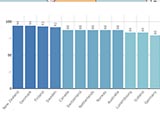
Corruption Ups and Downs Around the World
A Romanian once famously replied to a complaint from an EU official regarding the rampant corruption in the country by saying that, actually, the EU should be thankful that this corruption exists: “It makes sure that things work”. Without it, he implied, things would grind to a halt.
That may well be so. You need to renew your driving licence quickly? Well, just a little something for the coffee pot, you know, and there you have it. A couple of kilos above the checked baggage limit? Nothing erases the offending excess weight better than, well, another contribution to the coffee pot. And so on. Yes, you get things done.
But the entire economy suffers. Corruption adds to operational costs and increases uncertainty in economic relationships.
How do countries score in this regard around the world? Which ones are squeaky clean, which ones have a sticky skin? DICE has prepared an interesting interactive chart on corruption perceptions.
Back in 1995, the squeakiest of the cleanest was the UK, leading a pack that included the US, France, Japan, Canada, Germany, Austria and Sweden. You might wonder, what happened to the eternally enlightened Scandinavians, with just one representative in this group? Well, don’t lose faith in the beacons of rightfulness just yet: the other Scandinavians had not been included in the sample.
China hovered on the lower mid-range, between Mexico and Brazil. At the very bottom of the scale was Turkey, on a par with Russia, India, Romania and, surprise, Malta. Russia at the time was under the government of Boris Yeltsin and still reeling after the collapse of the Soviet Union four years earlier. Romania was still twelve years from joining the EU.
In 1996, and here is the shocker, the squeakiest was Italy, having jumped from the mid-ranges to the very top. What had happened? A nationwide judicial investigation known as “Mani pulite” (clean hands) into the corruption system referred to as Tangentopoli had led to the uncovering of many a corrupted politician and ultimately to the demise of the country’s First Republic.
By that time, the other Scandinavians had been included in the poll and, of course, they all stood in the top echelon, which encompassed 17 countries. The UK had slipped somewhat, but was flanked by Denmark and Finland in that group: respectable company, by any measure.
The three most corrupt were Turkey, India and Malta, while Russia had edged slightly upwards.
By the end of the millennium, the Nordics hogged almost all the top spots, Denmark scoring a full 100, which is the most chemically clean you can get. The Nordics were joined by the nations that most aspire to Nordic-grade, New Zealand, Canada and the Netherlands. In Italy, by then, the mani pulite had gone back to mani sporche, the country slipping to the neighbourhood of Poland and Greece. Turkey, in turn, had improved to the level of Mexico, and the most corrupt was now Russia, which was undergoing Vladimir Putin’s first prime ministership.
Come 2007, when the financial crisis erupted, Malta, the bad boy of the mid-90s, had climbed to a quite respectable upper-mid-range: the wonders of EU membership. China had slipped to the level of Romania, while Russia had been displaced from the bottom rung by Macedonia, with India just slightly less corrupted.
By 2010, New Zealand had out-Nordic’ed the Nordics and become No. 1, followed by, well, the Nordics. Italy had become a loyal neighbour of Greece and Turkey, while Serbia was giving company to Russia, which still reigned at the bottom.
Today, Russia continues to be the most corrupt of all, while Italy has slipped below the former low-scorer Macedonia, barely managing to best Romania and China. Maybe it wants to use a bit of mani sporche to make sure that things work?
Open the Corruption Comparisons interactive chart
This text is the responsibility of the writer and does not necessarily represent the opinion of CESifo or of DICE.
